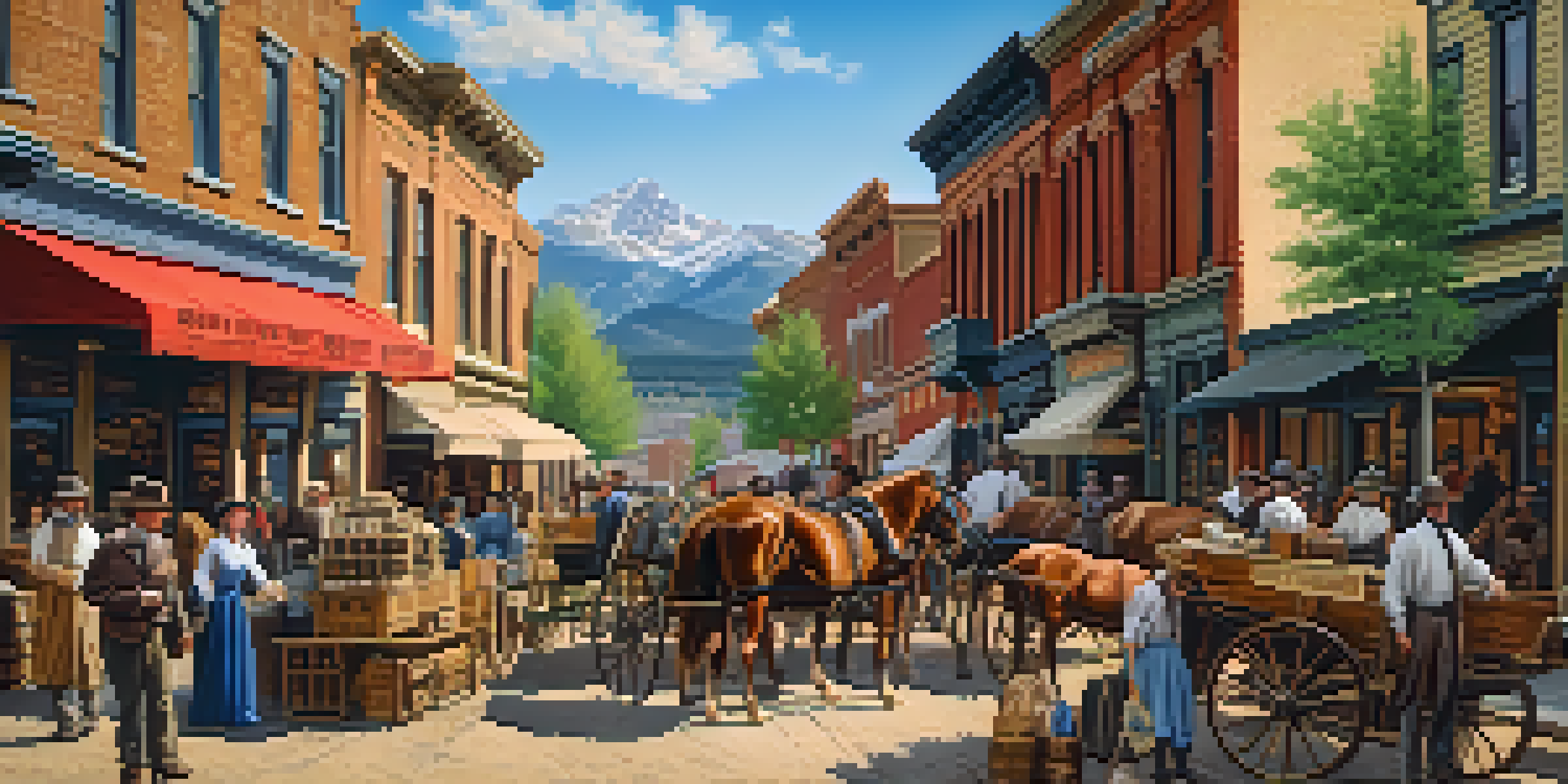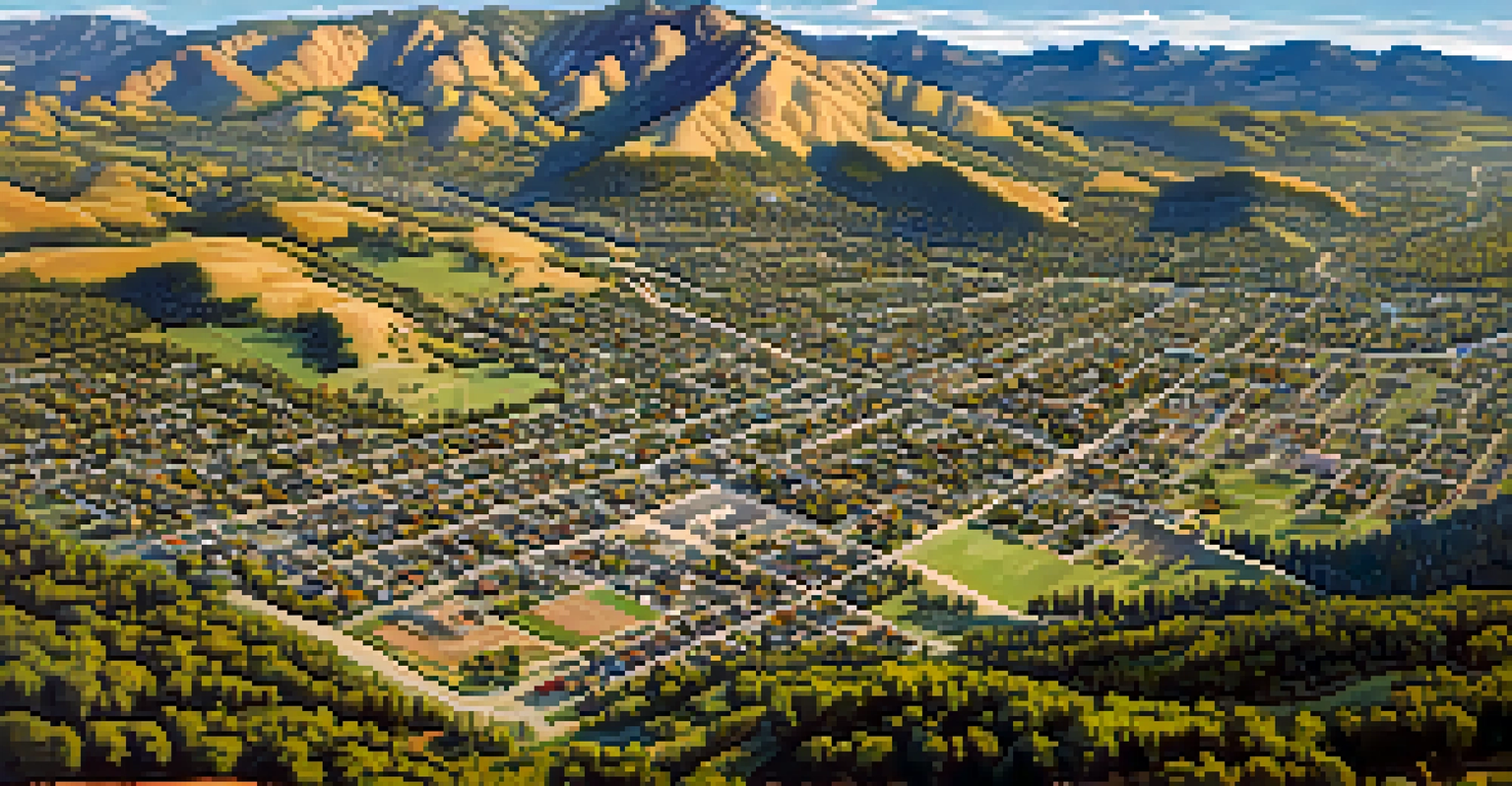The Gold Rush and Its Impact on Boulder’s Early Growth

Overview of the Gold Rush and Its Significance
The Gold Rush of the mid-19th century was a pivotal moment in American history, attracting fortune seekers to the West. It wasn't just about the gold; it represented hope and opportunity for many. In places like Boulder, Colorado, this influx of people would shape the future of the town and its economy.
Fortune favors the bold.
The discovery of gold in Colorado in 1858 sparked a massive migration, with thousands making their way to the region. While many aimed for the mountains, towns like Boulder became essential pit stops and places of settlement. The excitement surrounding gold fueled not just individual ambitions but also the collective spirit of a growing community.
As news of the Gold Rush spread, it created a domino effect, leading to the establishment of infrastructure and services in Boulder. This development laid the groundwork for what would become a thriving city, as miners and their families sought more than just gold—they sought a place to call home.
Boulder's Role as a Supply Hub During the Gold Rush
Boulder quickly transformed into a critical supply hub for miners heading to the goldfields. Merchants and suppliers flocked to the area, selling everything from tools to food, making the town a bustling center of commerce. This influx of businesses not only catered to miners' needs but also attracted more settlers looking for opportunities.

The presence of a reliable supply center made Boulder an attractive location for those seeking fortune in the surrounding mountains. As miners ventured out, they relied on Boulder's resources, which in turn stimulated local economic growth. This symbiotic relationship between miners and merchants established a strong economic foundation for the town.
Gold Rush Fueled Boulder's Growth
The Gold Rush attracted a diverse population to Boulder, driving economic and infrastructure development that transformed it into a thriving community.
Moreover, the establishment of transportation routes further enhanced Boulder's position as a supply hub. With easier access to surrounding areas, the town became vital for sustaining the gold rush activities, leading to an increased population and robust community structures.
The Development of Boulder's Infrastructure
As the Gold Rush attracted more settlers, Boulder's infrastructure evolved rapidly to meet the growing demands of its population. Roads, buildings, and services emerged, transforming the town from a simple settlement into a thriving community. This development was crucial for supporting the miners and their families who settled in the area.
The way to get started is to quit talking and begin doing.
The need for transportation and communication spurred investments in roads and railways, making it easier for goods and people to flow in and out of Boulder. These advancements not only facilitated trade but also connected Boulder to other burgeoning towns and cities in Colorado. The town's infrastructure became a backbone for future growth beyond the mining era.
Additionally, the establishment of schools, churches, and other community facilities began to shape a sense of identity among Boulder's residents. This shift from a transient mining camp to a more permanent settlement laid the groundwork for Boulder's long-term development.
Population Growth and Demographic Changes
With the Gold Rush came a wave of diverse populations, each bringing unique cultures and backgrounds to Boulder. This influx included not just miners but also families, entrepreneurs, and immigrants seeking better lives. As a result, Boulder became a melting pot of ideas, traditions, and lifestyles, enriching the community.
The demographic changes had a lasting impact on Boulder's social fabric. As residents settled down, they began to establish schools, churches, and social organizations that reflected their diverse backgrounds. This sense of community played a vital role in Boulder's identity, fostering unity amidst the varied influences.
Boulder: A Supply Hub Emerges
As a critical supply hub during the Gold Rush, Boulder became a bustling center of commerce, supporting miners and fostering local economic growth.
Moreover, the growing population led to increased demands for services and amenities, prompting further economic development. Businesses adapted to cater to the needs of families and long-term residents, shifting the focus from solely mining to a more balanced economy.
The Legacy of the Gold Rush on Boulder’s Economy
The Gold Rush left an indelible mark on Boulder's economy, setting the stage for a transition from mining to more diversified industries. While gold eventually became less prominent, the entrepreneurial spirit sparked during the Gold Rush continued to thrive. This laid the groundwork for Boulder's future as a center for innovation and commerce.
The infrastructure established during the rush, including roads and communication networks, facilitated the growth of various sectors, from agriculture to tourism. Boulder's natural beauty and proximity to the mountains attracted visitors long after the gold was gone, further diversifying its economy.
Additionally, the community's resilience and adaptability became defining characteristics of Boulder. As the town transitioned away from mining, the lessons learned during the Gold Rush helped shape its approach to future challenges and opportunities.
Cultural Impact: The Spirit of Adventure and Innovation
The Gold Rush instilled a spirit of adventure and innovation in Boulder that resonates to this day. The pursuit of fortune inspired generations to think outside the box and embrace new ideas. This culture of exploration and creativity has become a hallmark of Boulder's identity.
The legacy of the Gold Rush can be seen in Boulder's thriving arts scene, entrepreneurial ventures, and educational institutions. The community's willingness to take risks and pursue dreams has attracted diverse talent, fostering an environment where innovation flourishes. This has positioned Boulder as a hub for startups and creative industries.
Legacy of Innovation and Resilience
The spirit of adventure and innovation from the Gold Rush era continues to influence Boulder's identity, promoting a diverse and resilient economy today.
Furthermore, the adventurous spirit of those early settlers is reflected in the outdoor lifestyle Boulder promotes. The town’s connection to nature and emphasis on exploration can be traced back to the same daring individuals who ventured into the mountains in search of gold.
Modern Boulder: A City Shaped by Its Gold Rush Roots
Today, Boulder is a vibrant city with a rich history, largely shaped by the events of the Gold Rush. The foundations laid during that period have evolved, leading to a community that values sustainability, innovation, and inclusivity. Boulder's historical roots are a source of pride for its residents.
While the gold may have run out, the spirit of entrepreneurship and community continues to thrive. The lessons learned during the Gold Rush era have influenced Boulder's approach to economic development, emphasizing resilience and adaptability. This legacy is evident in the city’s diverse economy and strong community ties.

As Boulder looks to the future, it remains committed to honoring its past while embracing new opportunities. The Gold Rush may have been a chapter in its history, but its impact continues to shape the identity and aspirations of this remarkable city.